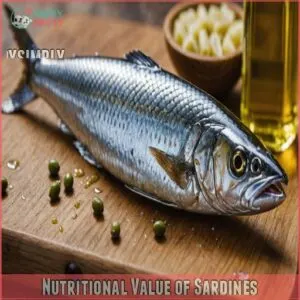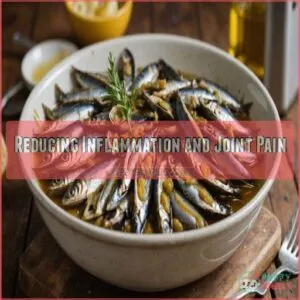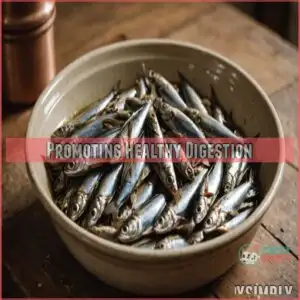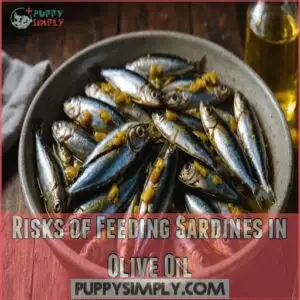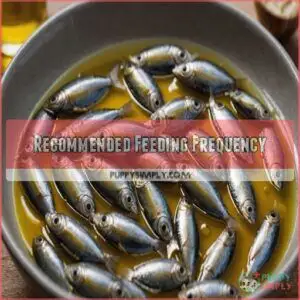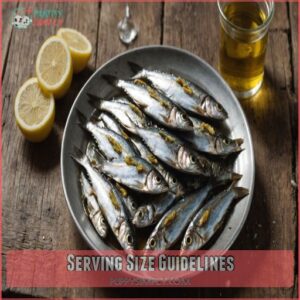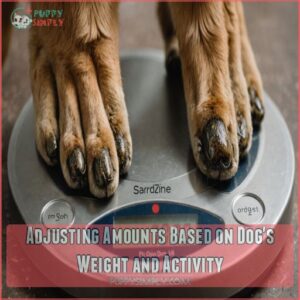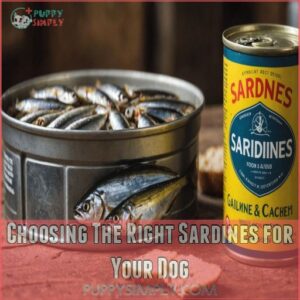This site is supported by our readers. We may earn a commission, at no cost to you, if you purchase through links.
 Yes, dogs can eat sardines in olive oil, but moderation is key.
Yes, dogs can eat sardines in olive oil, but moderation is key.
Sardines are a great source of protein and omega-3 fatty acids, which promote a shiny coat and healthy skin.
However, when these tasty little fish swim in olive oil, they pack more calories and fats, potentially leading to weight gain.
It’s like letting your dog attend an all-you-can-eat buffet—tempting but tricky!
Watch for any digestive upset or allergies and always consult your vet if unsure.
Choose high-quality, wild-caught sardines without added salt or preservatives.
Curious about more dog-friendly culinary delights? There’s plenty more to chew over!
Table Of Contents
- Key Takeaways
- Nutritional Value of Sardines
- Benefits of Feeding Sardines in Olive Oil
- Risks of Feeding Sardines in Olive Oil
- Feeding Guidelines for Sardines in Olive Oil
- Precautions and Considerations
- Choosing The Right Sardines for Your Dog
- Frequently Asked Questions (FAQs)
- Can dogs eat sardines packed in olive oil?
- Can dogs eat sardines in water?
- Can dogs eat frozen sardines?
- Why do dogs eat sardines?
- Are There Any Risks to Feeding Your Dog Sardines?
- Can Dogs Eat Canned Sardines?
- What Other Canned Fish For Dogs Should I Consider?
- How Should I Go About Feeding Dogs Sardines?
- How Often Should I Feed Sardines to My Dog?
- How much sardine can a dog have?
- Which canned sardines are best for dogs?
- Can dogs eat with olive oil?
- What kind of canned fish can I give my dog?
- How much sardine is safe for puppies?
- Can sardines in olive oil cause allergies?
- Are sardines suitable for all dog breeds?
- How often should sardines be served?
- Can sardines aid in dogs weight management?
- Conclusion
Key Takeaways
- You can feed your dog sardines in olive oil in moderation – it’s a great source of omega-3 fatty acids, protein, and vitamins that support coat health, joint function, and the immune system.
- You’ll need to limit servings to once or twice a week and adjust portions based on your dog’s size – one or two sardines per serving is typically sufficient for most dogs.
- You should only choose high-quality, wild-caught sardines without added preservatives or excess salt, and always remove the bones before feeding.
- You must watch for signs of allergies, digestive upset, or pancreatitis – if your dog shows any adverse reactions, stop feeding sardines and consult your veterinarian.
Nutritional Value of Sardines
When you feed your dog sardines, they’re getting a hearty dose of omega-3 fatty acids, Vitamin D, and Vitamin B12, which are essential for their health.
These tiny fish also pack a punch with protein, amino acids, and antioxidants, contributing to strong muscles and a robust immune system.
Rich Source of Omega-3 Fatty Acids
Sardines in olive oil are a jackpot of omega-3 benefits for your dog. Dogs can eat olive oil in their food, which provides numerous benefits, including enhanced skin and coat health, aiding weight management, boosting appetite, and supporting immune and cognitive function, as seen in olive oil for dogs. Sardines in olive oil are a jackpot of omega-3 benefits for your dog.
Think of these fatty acids as a superhero for dog coat health, fighting off skin allergies, easing joint pain, and boosting your pet’s immune system.
If you’re looking to incorporate sardine-based omega-3 supplements into your dog’s diet, consider shopping for dog sardine omega-3 products.
It’s like giving them a tiny shield of health, keeping them spry and shiny without breaking the bank.
High in Vitamin D and Vitamin B12
You know how omega-3s are a big deal for your dog’s health?
Well, sardines in olive oil are also packed with vitamin D and B12, bringing some serious benefits for bones and an immune boost.
Your dog’s energy levels will thank you too!
Here are three reasons these vitamins matter:
- Bone Growth
- Hair Health
- Good for Eyes
Good Source of Protein and Amino Acids
Imagine giving your dog a little protein boost with sardines.
These fish are a powerhouse for canine nutrition, providing high-quality protein essential for muscle growth and repair.
Packed with beneficial amino acids, sardines help maintain your dog’s health and energy.
Integrating sardines into your dog food routine might just turn meal times into a tail-wagging event!
Rich in Antioxidants and Coenzyme Q10
Besides protein, sardines also pack a powerful punch of antioxidants.
These help protect your dog’s cells from damage.
Think of them as tiny superheroes fighting off the bad guys!
Coenzyme Q10 (CoQ10) is another star player.
- CoQ10 supports heart health.
- It boosts energy levels.
- It helps with cell function.
- It’s an added bonus in sardines!
Choosing high-quality sardines helps your furry friend get the best of these antioxidant and CoQ10 benefits.
When introducing sardines in olive oil to your dog’s diet, be aware that plain olives are high in sodium, which can be a concern. Always check the label for added preservatives or fillers, and remember moderation is key for the best dog health benefits.
Benefits of Feeding Sardines in Olive Oil
Feeding your dog sardines in olive oil can enhance their skin and coat health while reducing inflammation and joint pain.
Sardines are also a good source of omega-3 fatty acids, which are important for a variety of health benefits.
Additionally, these fish support immune system function and promote healthy digestion, making them a nutritious choice for your furry friend.
Improving Skin and Coat Health
Sprinkling sardines into your dog’s meal can work wonders on dry skin, transforming it into a shiny coat you’ll adore.
These little fish aren’t just a tasty treat but a natural solution to doggy allergies.
Compared to store-bought supplements, sardines feel like homemade treats straight from nature, offering nourishment without artificial additives.
That’s real grooming made simple.
Reducing Inflammation and Joint Pain
After boosting their coat, see how sardines in olive oil can ease your dog’s aches.
These fish are like little joint supplements from the sea. Sardines provide omega-3 benefits, which offer natural remedies for reducing inflammation and joint pain.
Here’s how they help your dog: 1. Soothes arthritis in dogs.
- Enhances joint health.
- Promotes flexibility and mobility.
Supporting Immune System Function
Sardines in olive oil don’t just tackle joint pain; they also boost your pup’s immune system.
Packed with omega-3s, these little fish are nature’s way of supporting your dog’s defenses against allergies and infections.
In addition to sardines, other puppy food for immune system like vitamin-rich foods, lean meats, and probiotics can also support a strong immune system.
It’s like an immunity-boosting superhero cape.
Check the table below for added benefits!
| Benefit | Source | Effect on Dogs |
|---|---|---|
| Omega-3 Benefits | Sardines | Stronger immune function |
| Natural Remedies | Olive Oil | Reduced allergies |
| Dietary Supplements | Sardines | Enhanced defense |
Promoting Healthy Digestion
Your dog’s gut health can really get a boost from sardines in olive oil, offering nutritious perks packed with prebiotics and probiotics.
Here’s why they help digestion:
- Fiber-rich sardines support regular bowel movements.
- Probiotics enhance beneficial gut bacteria.
- Digestive enzymes aid nutrient absorption.
- Omega-3s reduce gut inflammation.
Adding a little fishy goodness might be just what your pup needs!
Risks of Feeding Sardines in Olive Oil
When feeding your dog sardines in olive oil, it’s important to weigh potential risks like digestive upset and mercury contamination.
Be cautious of allergies to fish or olive oil and the increased risk of pancreatitis, which could impact your dog’s health.
Potential for Digestive Upset
Occasionally, even small amounts of sardines can upset your dog’s stomach.
Some dogs have sensitive systems, and too much rich food can cause diarrhea or vomiting.
Start with a tiny portion to check for any tummy troubles.
Monitor your pup closely for signs of upset.
If you notice anything, reduce the amount or switch to fish oil alternatives.
Remember, a little goes a long way!
Always prioritize your dog’s digestive health.
Risk of Mercury Contamination
When feeding your dog sardines, you might wonder about mercury levels.
Sardines are generally low on the food chain, meaning they’ve lower mercury levels.
However, you still need to be cautious.
Choose wild-caught sardines over farmed ones for safer mercury levels.
Regularly check your fish oil’s mercury testing results to avoid unwanted health issues.
It’s all about balance!
Possibility of Allergies to Fish or Olive Oil
Fish allergies in dogs aren’t rare, and sardines can trigger them.
Watch out for signs like itchy skin or upset stomach.
If you’re concerned about your dog’s allergies, you can consult a guide on hypoallergenic dog foods to find brands that might be better suited for their needs.
Olive oil allergies might sneak up too.
Keep an eye on reactions:
- Lethargy
- Sneezing
- Swelling
- Vomiting
- Diarrhea
Managing allergies might mean finding alternative treats.
Trust your gut, and if your pup seems off, seek vet advice.
Increased Risk of Pancreatitis
While some dogs might tolerate fish, feeding sardines in olive oil bumps up fat content, nudging the risk of pancreatitis a nudge closer.
Picture your pup’s diet as a balanced see-saw; too much on the fatty side can tilt things off kilter.
These rich treats aren’t worth a vet visit.
Stick with vet advice and keep that see-saw steady!
Feeding Guidelines for Sardines in Olive Oil
When feeding sardines in olive oil to your dog, it’s important to get the portion sizes and frequency right to avoid digestive issues.
Keep an eye on your dog’s reactions and adjust portions based on their weight and activity level, ensuring they enjoy the tasty benefits without the side effects.
Recommended Feeding Frequency
Feeding sardines in olive oil to your dog should be about balance, like walking a tightrope.
Here’s a quick guide:
- Offer sardines as a treat, not a staple.
- Limit servings to once or twice a week.
- Keep treats to 10% of your dog’s daily intake.
- Consider age, breed differences, and activity level for best results.
Serving Size Guidelines
Serving sardines to dogs is like picking the right dance partner; it needs balance.
Start with a sardine or two, depending on your dog’s weight and activity level.
Consider their age and breed, as larger dogs may handle more.
Sardines should be treats, not meals, making up only a small part of their diet.
Keep it moderate and enjoyable!
Monitoring for Adverse Reactions
After giving your pup a sardine, keep a close eye on them, especially if they’ve a sardine allergy.
Watch for signs of trouble like signs of sardine allergy in dogs here, such as skin rash or loss of appetite.
A skin rash or loss of appetite could also mean something’s amiss.
If you notice any of these, stop giving sardines and chat with your vet.
It’s better to be safe than sorry!
Adjusting Amounts Based on Dog’s Weight and Activity
It’s important to keep an eye on your dog’s weight and energy levels while offering sardines.
Tailor the serving size to their size and activity level.
Consider:
- Dog size: Larger dogs can handle more.
- Activity level: Active dogs burn more calories.
- Calorie needs: Treats shouldn’t exceed 10% of their daily calories.
Adjust as necessary for a happy, healthy pup.
Precautions and Considerations
Before feeding sardines in olive oil to your dog, make sure they aren’t packed in salt or high-fat oils and always remove the bones.
It’s wise to consult your veterinarian first, especially if your dog has any health conditions, and consider alternatives if needed.
Avoiding Sardines Packed in Salt or High-Fat Oils
When feeding sardines in olive oil to your furry friend, skip those packed in salt or high-fat oils.
Too much salt can be a slippery slope to dehydration, while excess fat might invite digestive dilemmas.
Keep it simple and safe by choosing wisely.
| Do | Don’t | Why |
|---|---|---|
| Check labels | Ignore ingredients | Makes sure safety |
| Choose low salt | Use canned oils | Reduces risk |
| Look for olive oil | Opt for any oil | Protects health |
Removing Bones Before Feeding
Understanding the risks of sardines in high-fat oils helps you focus on Bone Removal Safety before feeding.
Tiny bones can pose Choking Hazards and cause Digestive Issues.
Follow these steps for a safer treat:
- Gently flake sardines to expose bones.
- Use a fork or tweezers for Bone Removal Tips.
- Discard extras to be certain of safety.
Consulting With a Veterinarian Before Feeding Sardines
Before you toss sardines into your dog’s diet, a vet visit could spare some tail-wagging woes.
They’ll weigh in on dog health concerns, pre-existing conditions, and dosage recommendations.
Vet Consultation:
| Situation | Why It Matters |
|---|---|
| Health Concerns | Avoids adverse reactions |
| Pre-existing Conditions | Tailors to specific needs |
| Dosage Recommendations | Prevents overfeeding |
| Safety Check | Makes sure of safety and well-being |
Alternatives to Sardines for Dogs With Health Conditions
Not every dog can tolerate sardines, especially with conditions like pancreatitis or obesity.
Fortunately, there are alternatives.
Omega-3 supplements can provide those essential fatty acids without the fat.
Flaxseed oil or fish oil make good swaps, and exploring different dog food choices could work wonders.
Homemade dog biscuits, like those made with peanut butter, oats, and sweet potatoes, can be a safe and healthy alternative, plus wholesome dog treats, healthy treats designed for dogs with sensitivities keep them happy and wagging.
Choosing The Right Sardines for Your Dog
Choosing the right sardines is key to ensuring your pup gets the nutritional benefits without any unwanted surprises.
Look for high-quality, wild-caught sardines packed in olive oil, avoiding those with added preservatives or fillers – your dog’s tummy will thank you!
Selecting High-Quality, Wild-Caught Sardines
Always pick wild-caught sardines to help your dog get the best nutrition without the high mercury risks.
You can find high-quality wild-caught sardines in olive oil here on this website.
Canned sardines are convenient, but checking their origin helps ensure ethical sourcing and lower mercury levels.
Fresh sardines often mean higher nutritional value and lower environmental impact.
Remember, the sustainability of sardines contributes to their overall quality and your dog’s health.
Opting for Sardines Packed in Olive Oil
Choosing sardines packed in olive oil for your dog can offer multiple benefits, like healthier skin and a shinier coat.
Here’s how to pick the best:
- Check labels for quality olive oil, ensuring it’s extra virgin.
- Inspect for bones in the sardines.
- Ensure serving frequency aligns with a balanced diet.
- Consider alternative options if your pup has dietary concerns.
Avoiding Sardines With Added Preservatives or Fillers
While opting for sardines packed in olive oil, you also want to steer clear of those with added preservatives or fillers.
Similar to how you’d approach choosing high-quality dog food that meets AAFCO nutritional standards best dog food brands, these additives can negate the health benefits your dog would otherwise enjoy.
Make checking labels a habit; seek organic options without unnecessary processing.
When you choose natural over processed, you’re ensuring your furry friend’s safety and wellbeing.
Frequently Asked Questions (FAQs)
Can dogs eat sardines packed in olive oil?
Ever wondered if your dog can enjoy sardines in olive oil?
They can, but keep it moderate; the oil’s fat content might lead to weight gain or pancreatitis.
Opt for high-quality, wild-caught sardines for best results.
Can dogs eat sardines in water?
Yes, dogs can eat sardines packed in water!
Just make sure to remove the bones first.
A tiny bit as a treat is fine, but don’t overdo it.
Too much fish can upset their tummy.
Can dogs eat frozen sardines?
Picture sardines as little ice cream cones of omega-3s for dogs.
Frozen sardines can be a tasty treat, boosting skin and coat health.
Just make sure to feed them in moderation to avoid digestive upset, and check for fish allergies.
Why do dogs eat sardines?
Dogs eat sardines for their rich omega-3 fatty acids, which boost skin and coat health.
The fish also offers essential nutrients like protein and vitamins, supporting joint health and strengthening the immune system.
They’re a tasty, nutritious treat!
Are There Any Risks to Feeding Your Dog Sardines?
Feeding your dog sardines might sound like a great idea, but be cautious of mercury content, digestive upset, and potential allergies.
Too many sardines can lead to pancreatitis, so consult your vet for personalized advice.
Can Dogs Eat Canned Sardines?
Sure, you can feed your dog canned sardines, similar to canned tuna safety.
They offer nutrients like omega-3 for skin and coat health.
Just make sure they’re plain or in water, as added oils or sauces can upset your dog’s stomach.
What Other Canned Fish For Dogs Should I Consider?
Ever give a dog mackerel or canned salmon?
These options are great too!
They’re packed with omega-3s and vitamins.
Just make sure they’re in water and deboned.
Your furry pal will surely wag their tail in approval!
How Should I Go About Feeding Dogs Sardines?
Start by introducing sardines slowly to your dog’s diet, no more than once or twice a week.
Make sure sardines are high-quality, removing bones, and watch for allergies.
Always check with your vet for personalized advice.
How Often Should I Feed Sardines to My Dog?
Feed your pup sardines sparingly, maybe once or twice a week as a tasty treat.
Don’t overdo it; too much of a good thing can upset their tummy.
Always check with your vet first!
How much sardine can a dog have?
About 63% of dog owners give treats occasionally. Regarding sardines, offer small amounts, just 1-2 sardines, once or twice a week. Start with a tiny bite, watching for any allergic reactions.
Which canned sardines are best for dogs?
Opt for high-quality, wild-caught sardines packed in water or their own juice, not brine.
Look for low sodium options to make sure your furry friend stays healthy.
They offer lots of nutrients while keeping your dog’s diet balanced.
Can dogs eat with olive oil?
When serving sardines to your dog, using olive oil peps up their diet.
However, make sure moderation as too much fat can upset their stomach.
Always opt for high-quality sardines and consult your vet for safety.
What kind of canned fish can I give my dog?
You can give your dog canned fish like sardines, mackerel, or salmon.
Make sure they’re packed in water for lower fat content.
Avoid seasonings or sauces, and always make sure bones are removed for safety.
How much sardine is safe for puppies?
For puppies, start with a small sardine piece once a week.
Watch for any allergies or upset stomachs.
Gradually increase as they grow.
Sardines offer beneficial nutrients but need to fit into their regular diet.
Can sardines in olive oil cause allergies?
Sardines in olive oil can trigger allergies in some dogs, especially if they’re sensitive to fish or olive oil.
Watch for signs like itching or digestive issues.
If your dog reacts, consider safer options and consult your vet.
Are sardines suitable for all dog breeds?
Like a picky eater, some dogs mightn’t tolerate sardines.
Generally, they’re okay for most breeds, but always check with your vet first, especially if your dog has allergies or health issues.
Moderation is key!
How often should sardines be served?
You should serve sardines to your dog no more than once or twice a week.
Gradually introduce them to avoid tummy troubles.
Always check with your vet to make sure it’s a healthy choice for your pet.
Can sardines aid in dogs weight management?
Imagine a dog’s shiny coat and energetic wag – sardines, with their omega-3 fatty acids, might just be the secret.
They support a healthy weight when given in moderation, boosting metabolism and keeping your pup spry.
Conclusion
Imagine this: your dog wagging its tail happily after a tasty snack.
Sardines in olive oil can be part of this happy scene when given carefully.
While they offer numerous nutritional benefits, including rich omega-3s and vitamins, sardines can also pose risks like digestive issues or allergies.
Always monitor your dog’s health and consult your vet to make sure safety.
If you’re wondering, "Can dogs eat sardines in olive oil?" remember, moderation is the key to keeping those tails wagging!

